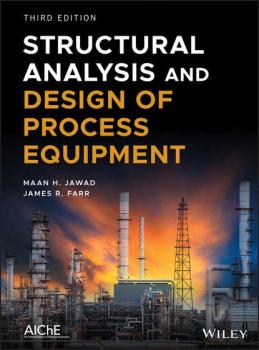ТОП просматриваемых книг сайта:
Maan Jawad H.
Список книг автора Maan Jawad H.Аннотация
Still the only book offering comprehensive coverage of the analysis and design of both API equipment and ASME pressure vessels This edition of the classic guide to the analysis and design of process equipment has been thoroughly updated to reflect current practices as well as the latest ASME Codes and API standards. In addition to covering the code requirements governing the design of process equipment, the book supplies structural, mechanical, and chemical engineers with expert guidance to the analysis and design of storage tanks, pressure vessels, boilers, heat exchangers, and related process equipment and its associated external and internal components. The use of process equipment, such as storage tanks, pressure vessels, and heat exchangers has expanded considerably over the last few decades in both the petroleum and chemical industries. The extremely high pressures and temperatures involved with the processes for which the equipment is designed makes it potentially very dangerous to property and life if the equipment is not designed and manufactured to an exacting standard. Accordingly, codes and standards such as the ASME and API were written to assure safety. Still the only guide covering the design of both API equipment and ASME pressure vessels, Structural Analysis and Design of Process Equipment, 3rd Edition: Covers the design of rectangular vessels with various side thicknesses and updated equations for the design of heat exchangers Now includes numerical vibration analysis needed for earthquake evaluation Relates the requirements of the ASME codes to international standards Describes, in detail, the background and assumptions made in deriving many design equations underpinning the ASME and API standards Includes methods for designing components that are not covered in either the API or ASME, including ring girders, leg supports, and internal components Contains procedures for calculating thermal stresses and discontinuity analysis of various components Structural Analysis and Design of Process Equipment, 3rd Edition is an indispensable tool-of-the-trade for mechanical engineers and chemical engineers working in the petroleum and chemical industries, manufacturing, as well as plant engineers in need of a reference for process equipment in power plants, petrochemical facilities, and nuclear facilities.
Аннотация
An illustrative guide to the analysis needed to achieve a safe design in ASME Pressure Vessels, Boilers, and Nuclear Components Stress in ASME Pressure Vessels, Boilers, and Nuclear Components offers a revised and updatededition of the text, Design of Plate and Shell Structures. This important resource offers engineers and students a text that covers the complexities involved in stress loads and design of plates and shell components in compliance with pressure vessel, boiler, and nuclear standards. The author covers the basic theories and includes a wealth of illustrative examples for the design of components that address the internal and external loads as well as other loads such as wind and dead loads. The text keeps the various derivations relatively simple and the resulting equations are revised to a level so that they can be applied directly to real-world design problems. The many examples clearly show the level of analysis needed to achieve a safe design based on a given required degree of accuracy. Written to be both authoritative and accessible, this important updated book: Offers an increased focus on mechanical engineering and contains more specific and practical code-related guidelines Includes problems and solutions for course and professional training use Examines the basic aspects of relevant theories and gives examples for the design of components Contains various derivations that are kept relatively simple so that they can be applied directly to design problems Written for professional mechanical engineers and students, this text offers a resource to the theories and applications that are needed to achieve an understanding of stress loads and design of plates and shell components in compliance with pressure vessel, boiler, and nuclear standards.


